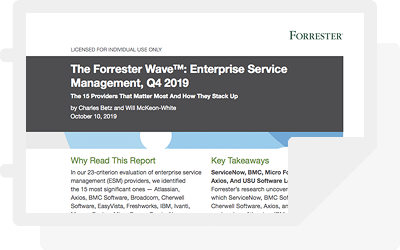Imagine going to your favorite restaurant with your friend and the waiter gives you different menus. It soon dawns on you that your friend gets something better than you simply because it was in their menu but not yours. (You may then feel shortchanged and not enjoy your time together.) This same principle applies to the service catalog. Customers will not be pleased if the information on available services you have provided them is different from what you’re giving other customers.
In ITSM, the service catalog is one of the most important elements—yet it is often overlooked. While most service providers are keen to invest in ticketing tools for requests, incidents, problems, and changes, you may consider the catalog as a mere reference item for these tickets. Instead, service catalogs are most valuable when you first identify, then describe, your services in a way that customers can appreciate.
In this article, we will:
- Define a service catalog and its benefits
- Explain the differences between business service catalogs and technical service catalogs
- Provide best practices for creating and maintaining service catalogs
What is a service catalog?
A service catalog maintains information on all services that you currently offer to customers. A service catalog should be a subset of your entire service portfolio, likely because not all services are currently available. A document, an online portal, a website shopping experience, or other forms can all comprise your service catalog.
A service catalog might feel superfluous or unnecessary—why do you need to spell out your services to your customers? (The first problem may be that you’re struggling to define your services.)
In fact, service catalogs offer immense value and benefits. When a customer knows what to expect from your service, the customer can get in touch quickly and easily when that expectation isn’t met. Consider the opposite: if a customer thinks you do X, but you really do Y, the customer will not be happy. A service catalog can also help you identify areas for self-service, which is quickly becoming an ITSM best practice and promotes customer satisfaction. Internally, service catalogs clarify workloads and work expectations for the entire company: who are our customers? What are our processes? When something goes wrong with a certain service, how and where is it escalated? The best service catalogs answer all these questions.
Be aware that all details related to a service, such as technical specifications, offerings, SLAs, and costs, may not apply to every type of customer. Because your overall service catalog is extensive and used broadly, maintaining two different views into the service catalog can delineate needs and information per stakeholder. These two views are encompassed in the business service catalog and the technical service catalog.
It is imperative that the service provider maintains a single source of consistent information that the catalog views reference. The services information must be detailed appropriately to support stakeholder engagement and service delivery. And, you must make a concerted effort to ensure that the catalog is updated frequently based to reflect new, modified, or retired products and services. (See more service catalog best practices below.)
Defining a business service catalog
The business service catalog is the service catalog view that is shared with users and customers. Without a business service catalog, the service provider has trouble articulating what products and services they offer. Thus, the consumer is challenged to choose what service they want as the information provided is limited. The clearer the services are, the more quickly a consumer can access a service—and the better chance you’ll have a satisfied customer. A good example of a business service catalogue is what you see on an ecommerce website or app store, in a platform like BMC Helix Digital Workplace, or at University of New Mexico, which serves as both a school and a workplace.
A business service catalog contains information on services directly consumed by the users as well as relationships to user roles and processes. This category of stakeholders is interested in information concerning consumption of services. Interests in the business service catalog would include the following:
- User information, such as requesting and provisioning of services
- Customer information, such as service descriptions, service levels, and financial costs
Here are some types of information that is visible in a business service catalog:
- Service name. The name by which the service provider and the service consumer reference the service
- Service description. A summary of what the service does and the outcomes it helps the consumer achieve
- Service type/category. How the service has been categorized based on the provider’s offerings
- Service levels. Expected service performance targets the provider intends to achieve
- Service costs. Expected cost for the consumer to access/use the service
- Service hours. Time periods when the service provider can provide the service
- Service support. How the consumer can expect the provider to address any service issues, such as requests or incidents
Within your company, certain people are more inclined to use the business service catalog than the technical service catalog. The business service catalog is an important tool for anyone involved in sales and business development, as it supports engagement with and marketing of the service provider’s products and services to potential and current customers. It also serves as the reference for ordering and requesting services when interfaced with the service provider’s service portal or web catalogue.
Defining a technical service catalog
The technical service catalog (sometimes known as the ‘supporting service catalog view’) contains information relevant to the service provider around delivery and support of the service to meet customers’ needs. This includes technical, security, and process information for use in service delivery, which is not relevant for service consumers.
The technical service catalog, along with configuration information, outlines how business and technical services and processes work together to provide value to the customers. It is a valuable tool for teams involved in the various value chain activities of creating, managing, and supporting the services such as service desks, developers, and support and product teams. AWS has a good example of a technical service catalog.
Without a technical service catalog, there is no visibility into how underlying components support the service in order to meet customer need. Imagine a situation where a user contacts the service desk complaining about a service, and the agent has no reference point on the service, its importance, or how the service is to be handled.
Information included in a technical service catalog includes, but certainly isn’t limited to, the following:
- Supporting services. Business and technical services that support the main service or product
- Service customer. The customers currently consuming the service
- Service owner. The business person/unit who has been assigned responsibility for the service, such as the product owner or product manager
- Service priority. The importance of the service compared to other services as determined by the organization in terms of revenue and customer classification
- Service escalation. How the service is supported by different levels of technical teams and how issues are escalated from one team to another
- Security rating. The value of security for the information handled by the product or service
How to create a service catalog
Both types of service catalog views are important in the overall scheme of IT service management. Both the service provider and the consumer have a lot to gain from well-maintained service catalog information, particularly when the information is current and useful. A stale service catalog serves no one in the service lifecycle.
If you’re ready to build a successful service catalog, start with these seven steps (part one and part two). Here are additional service catalog best practices:
- Ensure the information in each catalog view remains relevant to its stakeholders.
- Offer the catalog in various forms per customer and service provider preferences. (A mobile app may be useful for some companies, whereas a detailed document or online portal may be more appropriate for others.)
- Avoid creating separate or isolated service catalogs within different technology systems as this results in segregation, variability, and complexity.
- Review the catalog frequently for changes, updates, and retired options.
- Plan regular engagements between service providers and consumers on the different service catalog views to ensure they still provide value for requesting.
Additional Resources







